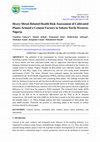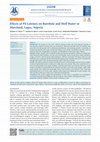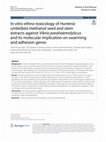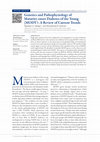Papers by Tajudeen O Yahaya, PhD Genetics and Toxicology
Introduction Contamination of rivers by microplastics (plastic debris; 0.1 µm to 5 mm in size) po... more Introduction Contamination of rivers by microplastics (plastic debris; 0.1 µm to 5 mm in size) poses a significant global challenge. Reports of this issue have surfaced across continents. Idowu et al (1) documented it in Africa, specifically in the River Osun, Nigeria, while Conard et al (2) observed it in an American river. Gao et al (3) reported findings in Europe, Sharifi et al (4) in Asia, and Leterme et al (5) in Australia. There are various sources of microplastics in rivers, including wastewater treatment plants (6), stormwater runoff (7), as well as atmospheric deposition and runoff from agricultural, recreational, industrial, and urban areas (8). Microplastics eventually enter the sea, contributing to marine microplastic pollution (9). The distribution of microplastics in water is heavily influenced
Pharmaceutical and biomedical research, Mar 7, 2023

Environmental analysis, health and toxicology, Jun 26, 2024
The global occurrence of microplastics and their poorly understood health implications underscore... more The global occurrence of microplastics and their poorly understood health implications underscore the need for scientific investigation. This study aimed to assess the effects of microplastics exposure. Twenty-five (25) albino rats (Rattus norvegicus) were divided into five (5) groups, each consisting of five rats. Group 1 (the negative control) received normal feed; group 2 (the positive control) was administered a 10 % lead acetate solution; and groups 3, 4, and 5 were administered 1 %, 5 %, and 10 % microplastic solutions, respectively. The rats were monitored for 28 days, after which blood samples were taken for hematological and lipid profiles as well as liver and kidney function parameters. The results revealed dose-dependent significant (p < 0.05) alterations in the health indices of the treated rats and the positive control compared with the negative control. Specifically, the hematological parameters, including the white blood cells (WBC) and its subtypes, were reduced, indicating immunosuppressive effects, and the red blood cells (RBC), hemoglobin (HGB), hematocrit (HCT), platelets, mean corpuscular volume (MCV), mean corpuscular hemoglobin (MCH), and mean corpuscular hemoglobin concentration (MCHC) were reduced, indicating anemia. The 1 % and 5 % microplastic solutions raised the lipid profiles of the treated rats, including total cholesterol (TC), triglycerides (TG), high-density lipoprotein (HDL), and low-density lipoprotein (LDL), while the 10 % concentration decreased them, causing hyperlipidemia and hypolipidemia, respectively. The liver function parameters, including total protein (TP), albumin (ALB), aspartate transaminase (AST), alanine transaminase (ALT), and alkaline phosphatase (ALP), were elevated, indicating liver damage. Elevation of kidney function parameters, including sodium ion (Na +), potassium ion (K +), chloride ion (Cl-), urea, and creatinine (CRT), were noticed, suggesting kidney injuries. It can be inferred from these results that microplastics are toxic. Hence, human exposure to microplastics should be reduced to a minimum.

Iranian journal of diabetes and obesity, Jun 15, 2024
Numerous suspect genes associated with type 1 diabetes mellitus (T1DM) have been identified, sugg... more Numerous suspect genes associated with type 1 diabetes mellitus (T1DM) have been identified, suggesting a need to focus on the disease&#39;s causal genes and mechanisms. This necessitates an update to raise public awareness. This review articulates genes with mutations that predispose individuals to T1DM. We conducted a comprehensive search of academic databases, including Web of Science, Scopus, PubMed, and Google Scholar, for relevant materials. Available information indicates that at least 70 genes are suspected in the pathogenesis of T1DM. However, the most frequently implicated genes include human leukocyte antigen (HLA), insulin (INS), cytotoxic T lymphocyte-associated antigen 4 (CTLA-4), and protein tyrosine phosphatase non-receptor type 22 (PTPN22). Mutations or variants in these genes may lead to insulin insufficiency and, consequently, T1DM by tricking immune cells, such as T-cells and B-cells, into attacking self-antigens and triggering the autoimmunity of beta cells. Furthermore, this pathophysiology can be mediated through aberrant epigenetic modifications, including DNA methylation, histone post-translational modifications, and noncoding RNAs, in the mentioned genes. Some of these pathophysiologies are gene-specific and may have an epigenetic origin that is reversible. In the event of an epigenetic origin, a treatment for T1DM that addresses the causal genes or reverses epigenetic changes and their mechanisms could yield improved outcomes. Medical professionals are encouraged to design therapeutic regimens that specifically target the mentioned genes and address the identified epigenetic alterations in individuals expressing such etiologies.

Deleted Journal, Mar 4, 2024
The pollution of the environment by cement manufacturing companies is becoming a global concern, ... more The pollution of the environment by cement manufacturing companies is becoming a global concern, particularly in developing nations. This study assessed the levels of heavy metals and their associated health risks in sugarcanes (Saccharum officinarum), tomatoes (Solanum lycopersicum), and almonds (Prunus dulcis) cultivated in the vicinity of a cement factory in Sokoto, Nigeria. Samples of these plants were collected, treated, and then assayed for lead (Pb), copper (Cu), cadmium (Cd), and zinc (Zn) using atomic absorption spectroscopy (AAS). The values obtained were compared against the permissible limits established by the World Health Organization (WHO), and these results were used to estimate the potential health risks associated with consuming these plants. The findings revealed that both the Solanum lycopersicum and Saccharum officinarum contained non-tolerable levels of Cu, Cd, Pb, and Zn, while Prunus dulcis had non-tolerable levels of Zn only. Additionally, the concentrations of individual heavy metals in each of the three plant species showed a significant difference (p ≤ 0.05) from the respective WHO standards. The estimated daily intake (EDI) and target hazard quotient (THQ) for all the heavy metals were within the recommended limits, except for the EDI of Pb in Saccharum officinarum and the THQ of Pb in Solanum lycopersicum. The health risk index (HRI) for all the heavy metals in the three plants exceeded the tolerable limit (> 1). These findings indicate that daily consumption of these plants may pose health hazards. Therefore, the practice of cultivating plants in the vicinity of cement factories should be discouraged.

Research Square (Research Square), Aug 31, 2023
Background: Computer devices have become an important part of human life because they make work e... more Background: Computer devices have become an important part of human life because they make work easier and thus increase output. However, the use of computer devices has led to the occurrence of computer vision syndrome (CVS). The current study was aimed at determining the demographic characteristics, in uence of ABO blood groups, and diseases associated with CVS in Lagos, Nigeria. Methods: Structured questionnaires were used to collect demographic information from 153 CVS patients at Unique Eyes Center, Lagos. The data collected includes age, gender, educational level, ethnicity, religion, type of device use, duration spent on devices, marital status, and diseases frequently expressed. The ABO blood groups of the participants were thereafter collected from their medical records. Results: The results showed that 89 (58.70%) of the respondents were males, while 64 (41.83%) were females. Most of the respondents were > 40 years old, with 78 members (50.98%), followed by age class 21-40 with 48 representatives (31.37%) and age class 10-20 with 27 members (17.65%). Respondents with primary education were 2 (1.31%), those with secondary education were 28 (18.30%), and those with tertiary education consisted of 123 members (80.39%). Married participants were 72 (47.06%), singles were 48 (31.37%), divorced were 18 (11.76%), and widowed were 15 (9.80%). Christians were 81 (52.94%), while Muslims were 72 (47.06%). The Yoruba ethnic group made up 78 (50.98%), the Igbo made up 43 (28.10%), and the Hausa/Fulani were 32 (20.92%). 110 (71.90%) used desktops, 28 (18.30%) used androids, and 15 (9.80%) used laptops or iPads. 116 (75.82%) participants used computer devices continuously, while 37 (24.13%) used them intermittently. People with non-O blood types constituted the majority, of which those with type A blood were the most affected, having accounted for 51 (33.33%) of the overall population. Headache, blurred vision, eye strain, double vision, and neck/shoulder/back pain were strongly associated with CVS in the study area. Conclusion: The results suggest that demographic characteristics and ABO blood groups genotypes in uence susceptibility to CVS among computer users in Lagos. Non-O blood group individuals, mainly type A blood are particularly at risk. People are advised to limit time spend on computer devices and get regular eye tests.

Industrial and Domestic Waste Management, Feb 6, 2024
The most common and cost-effective waste disposal method is the dumpsite; however, leachate from ... more The most common and cost-effective waste disposal method is the dumpsite; however, leachate from dumpsites may percolate and compromise groundwater sources. This study evaluated the levels of heavy metals (lead, cadmium, chromium, copper, and arsenic), physicochemical parameters (pH, electrical conductivity, total dissolved solids, hardness, calcium, magnesium, and chloride), and microorganisms in borehole water samples obtained at distances of 50, 100, 200, and 400 meters from the Igando dumpsite in Lagos, Nigeria. The health hazards associated with the heavy metals were also calculated. Physicochemical analysis indicated that the water samples were acidic, with pH values ranging from 4.30±0.01 to 5.21±0.008. They contained levels of calcium (166.73±0.01-328.66±0.06 mg/l), magnesium (83.72±0.02-119.40±0.17 mg/l), hardness (416.01±0.11 mg/l-820.00±1.63 mg/l), and chloride (20.07±0.02-120.90±0.81 mg/l) that exceeded the limits set by the World Health Organization. Heavy metal analysis showed that, in all locations, lead exceeded the permissible limits, cadmium exceeded the limits except for the 400-m location, and copper, chromium, and arsenic (except for the 50-m location) were within permissible limits. The average daily intake and hazard quotient of the heavy metals were both within recommended limits, but the carcinogenic risks of lead, cadmium, and copper in water collected at a distance of ≤100m exceeded the threshold. Microbiological examinations revealed non-permissible levels of bacteria at all locations, coliforms at the 400-m location, and fungi at the 50-m and 400-m locations. On average, the parameters significantly (p<0.05) increased in concentrations as the proximity to the dumpsite decreased. These findings indicate that borehole water is not suitable for drinking without treatment.

Introduction Fish consumption is widespread globally, to the extent that it is currently competin... more Introduction Fish consumption is widespread globally, to the extent that it is currently competing with beef as a staple food (1). This is attributed to its numerous nutritional and health benefits (2). Fish contains vitamins, proteins, omega-3 fatty acids, and various minerals (3,4). Furthermore, fish play a crucial role in the global economy, with many individuals relying solely on the fisheries industry for their income (5,6). In Nigeria, approximately 1.5 million people are employed in the fisheries sector, contributing over 1.0% to the national gross domestic product (GDP) in 2020 and 2021 (7). From a health perspective, regular fish consumption promotes glucose homeostasis, thyroid health, body weight maintenance, muscle mass preservation, and reduces the risk of diabetes mellitus, aging-induced high blood pressure, cardiovascular diseases, and metabolic syndrome (8,9). Fish are also utilized in ethnomedicine to treat parasitic and infectious diseases, as well as to manage pregnancy, delivery, and post-delivery (10). In Nigeria, aside from the nutritional and economic benefits, fish are integral to traditional healings, festivals, rituals, ceremonies, and sacrifices (11,12). Unfortunately, anthropogenic activities such as industrial, urban, and population growth are polluting water bodies and resources globally, jeopardizing the

Numerous suspect genes associated with type 1 diabetes mellitus (T1DM) have been identified, sugg... more Numerous suspect genes associated with type 1 diabetes mellitus (T1DM) have been identified, suggesting a need to focus on the disease's causal genes and mechanisms. This necessitates an update to raise public awareness. This review articulates genes with mutations that predispose individuals to T1DM. We conducted a comprehensive search of academic databases, including Web of Science, Scopus, PubMed, and Google Scholar, for relevant materials. Available information indicates that at least 70 genes are suspected in the pathogenesis of T1DM. However, the most frequently implicated genes include human leukocyte antigen (HLA), insulin (INS), cytotoxic T lymphocyte-associated antigen 4 (CTLA-4), and protein tyrosine phosphatase non-receptor type 22 (PTPN22). Mutations or variants in these genes may lead to insulin insufficiency and, consequently, T1DM by tricking immune cells, such as T-cells and B-cells, into attacking self-antigens and triggering the autoimmunity of beta cells. Furthermore, this pathophysiology can be mediated through aberrant epigenetic modifications, including DNA methylation, histone post-translational modifications, and noncoding RNAs, in the mentioned genes. Some of these pathophysiologies are gene-specific and may have an epigenetic origin that is reversible. In the event of an epigenetic origin, a treatment for T1DM that addresses the causal genes or reverses epigenetic changes and their mechanisms could yield improved outcomes. Medical professionals are encouraged to design therapeutic regimens that specifically target the mentioned genes and address the identified epigenetic alterations in individuals expressing such etiologies.

Bulletins of Natural and Applied Sciences, 2024
The potential health risks of cement dust exposure are increasingly raising concern worldwide as ... more The potential health risks of cement dust exposure are increasingly raising concern worldwide as the cement industry expands in response to rising cement demand. This necessitates the need to determine the nature of the risks in order to develop appropriate measures. This study determined the effects of cement dust exposure on the weight and blood glucose levels of people residing or working around a cement company in Sokoto, Nigeria. Demographic information was obtained using questionnaires from 72 participants, which included age, gender, educational level, exposure hours, occupation, and lifestyle. The blood glucose levels and body mass index (BMI) were measured using a Fine Test glucometer and a mechanical scale, respectively. The results showed that most of the people living or working around the cement company were middle-aged men (31-40; 42.06%) with a primary (33.33%) or secondary (45.83%) school education. It showed that 30 (41.69%) of the participants were overweight while 5 (6.94%) were obese. Additionally, 52.78% of the participants were diabetic while 31.94% were prediabetic. Participants that were exposed for long hours (> 15 hours per day) were the most diabetic (20% of the participants), followed by smokers (15%), and artisans (7%). It can be concluded that exposure to cement dust from the company increased the risk of overweight, obesity, and hyperglycemia among the participants. These health risks were worsened by daily long hours of exposure, smoking, and artisanal pollutant exposure. Human settlements and artisans should not be located near the cement company, and the company should minimize pollutant emissions.

BIOKEMISTRI, 2022
Soil is an important natural resource that is necessary for agricultural production. However, soi... more Soil is an important natural resource that is necessary for agricultural production. However, soil and plants grown in it can be contaminated by dumpsites, prompting their periodic assessment. This study assessed the levels of lead (Pb), nickel (Ni), cadmium (Cd), manganese (Mn), and copper (Cu) in soil and three vegetables (Solanum lycopersicum, Amaranthus viridis, and Lactuca sativa) around Halleluyah dumpsite in Zuru, Kebbi State, Nigeria. Plant and soil samples were collected at 5 cm, 10 cm, and 15 cm depths and analyzed. The heavy metals' average daily intake (ADI), average daily dermal exposure (ADDE), target hazard quotient (THQ), and health risk index (HRI) were also calculated. In the vegetables, Pb and Cd exceeded the World Health Organization permissible limits, Mn and Cu exceeded the limits only in S. lycopersicum, while Ni was within the limits. The heavy metals' THQ in the vegetables was within the recommended limits, but not their HRI (≥1). Except for Cd, the soil samples contained permissible levels of the heavy metals. However, the ADI of Cd, Mn, Ni, and Cu from the soil samples exceeded the recommended limits, while Pb was within the limits. The ADDE to the heavy metals via the soil samples was within the recommended limits, but not so for their THQ and HRI (≥1). It can be inferred from the results obtained that consumption of the vegetables and exposure to the soil may cause health hazards. Therefore, the dumpsite and its surrounding soil require heavy metal remediation and regular monitoring.
Journal of Natural Science, Engineering and Technology, Nov 6, 2019
Oladele et al., (2017), it was revealed that lead and zinc inhibited both seed germination and se... more Oladele et al., (2017), it was revealed that lead and zinc inhibited both seed germination and seedling growth especially lead. These effects were most significant on the roots compared to the shoots. Maise (Zea mays L.), a typical cereal crop of temperate and subtropical zones is displayed as a variable stress tolerant plant under environmental extremities. Maize is known as an important crop plant for the grain and fodder. With all these in view, the present study will investigate the effect of different metal concentrations on the germination and growth of this important cereal; maize (Zea mays L), soil parameters and soil microorganisms.
Ife Journal of Science, 2014

Journal of Advances in Environmental Health Research
Background: Pit latrines are the most common human excreta and urine disposal facilities in low-i... more Background: Pit latrines are the most common human excreta and urine disposal facilities in low-income countries because they are economical. However, leachate from the facilities may percolate into the ground and compromise groundwater, necessitating periodic monitoring of nearby groundwater. This study assessed the effects of pit latrines on borehole and well water in Adesoye, Barracks, Onigbongbo, Arowojobe, and Shonibare in Maryland, Lagos, Nigeria. Methods: Water samples were analysed for physicochemical parameters (electrical conductivity, total dissolved solids, hardness, calcium, pH, and chloride), heavy metals (lead, nickel, cadmium, copper, and zinc) and microbial content (bacteria, coliforms, and fungi). The mean values of each parameter was compared with the World Health Organization standards and used to calculate the average daily intake (ADI) and hazard quotient (HQ) of the heavy metals. Results: The physicochemical analysis revealed that each of the borehole and well...
Ruhuna Journal of Science, Aug 18, 2022

African Journal of Health, Safety and Environment, 2022
Energy drinks are sold worldwide because they boost physical and mental performance. However, stu... more Energy drinks are sold worldwide because they boost physical and mental performance. However, studies show that some of them contain high levels of heavy metals, prompting a safety evaluation of all brands of energy drinks. This study evaluated the safety of three brands of energy drinks (Fearless, Monster, and Power Horse) sold in Birnin Kebbi, Nigeria, with regard to heavy metal concentrations. The heavy metals evaluated are iron (Fe), copper (Cu), cadmium (Cd), zinc (Zn), and lead (Pb). Samples of the energy drinks were subjected to atomic absorption spectroscopy, and the results were compared with the World Health Organization standards for drinks. The average daily intake (ADI), hazard quotient (HQ), and carcinogenic risk (CR) of the heavy metals were also calculated. The levels of Fe, Cu, and Cd were above the permissible limits in all the energy drinks, while zinc (Zn) and lead (Pb) were below the permissible limits. The ADI of the heavy metals in the three energy drinks was ...

Tropical Aquatic and Soil Pollution
The Agboyi River in Lagos, Nigeria provides important ecosystem services; however, anthropogenic ... more The Agboyi River in Lagos, Nigeria provides important ecosystem services; however, anthropogenic activities are polluting the river, necessitating periodic monitoring. This study assessed the heavy metal content (lead, cadmium, chromium, copper, and arsenic) in water samples from the river. Additionally, we evaluated various physicochemical parameters, including pH, total dissolved solids (TDS), conductivity, hardness, magnesium, calcium, chloride, sulfate, and nitrate. The values of each heavy metal were used to calculate human average daily ingestion (ADI), average daily dermal exposure (ADDE), hazard quotient (HQ), and carcinogenic risk (CR). The physicochemical analysis revealed non-permissible levels of TDS, electrical conductivity, alkalinity, hardness, magnesium, calcium, sulfate, nitrate, chloride, and phosphate. The heavy metal analysis showed intolerable levels of lead, arsenic, cadmium, chromium, and copper. The ADIs for the heavy metals were within the recommended dietar...

Scientia Africana
Pesticides are widely used to boost agricultural output, thus making food consumption a major rou... more Pesticides are widely used to boost agricultural output, thus making food consumption a major route of human pesticide exposure. This study was aimed at determining the safety of pesticide residues in vegetables and fruits sold in Ikorodu Markets, Lagos, Nigeria. The vegetables analyzed were lettuce (Lactuca sativa), spinach (Spinacia oleracea), cabbage (Brassica oleracea), cucumber (Cucumis sativus), and onion (Allium cepa), while the fruits were orange (Citrus aurantium), mango (Mangifera indica), and guava (Psidium guajava). Samples of the vegetables and fruits were subjected to mass spectrometry (GC-MS) analysis, and the values obtained were compared with the minimum risk levels (MRLs) recommended by the World Health Organization (WHO). Thereafter, the estimated daily intake (EDI) and health risk index (HRI) of the detected pesticide residues were calculated and compared with the acceptable daily intake. The GC-MS analysis of the vegetables detected chlorepyrifos-ethyl beyond th...

Bulletin of the National Research Centre, Jul 3, 2023
Background Hunteria umbellatta (HU) is a predominant plant with a share of therapeutic properties... more Background Hunteria umbellatta (HU) is a predominant plant with a share of therapeutic properties against various human diseases with no scientific report of its in vitro ethno-toxicology coupled with molecular implication in the literature. This study, therefore, evaluated in vitro toxicological activity and quantification of expression of specific swarming gene, lateral flagellar (Laf A) and adhesion gene (ExsE) of Vibrio parahaemolyticus (VP) treated with methanol seed and stem extracts of HU at 500, 250, 125, 62.5, 31.25, 15.625, 7.8125, 3.90625 µg/µL concentrations. Results The toxicological results of all the eight tested concentrations from as low as 3.90625 µg/µL to as high as 500 µg/µL of HU seed and stem extracts revealed significantly (p ˂ 0.05) uninhibited bacterial growth in a dosedependent manner compared to controls (positive and negative). The quantity of Laf A and ExsE genes' expressions in VP was significantly higher (p ˂ 0.05) at 500 µg/µL of HU seed and stem compared to control while at 125 µg/µL of the same extract (seed and stem) showed significantly lowered (p ˂ 0.05) expression of swarming and adhesion genes in VP relative to control. Comparative to control, adhesion gene (ExsE) expression in VP significantly increased (p ˂ 0.05) at 250 µg/µL of HU seed and stem extracts. Conclusions The results obtained suggest toxicity at varying concentrations and higher concentration dosing of HU seed and stem is harmful as it could lead to increased expression of the gene colonization factor of VP as a major contributory agent of gastroenteritis.

arXiv (Cornell University), Jan 17, 2021
Single gene mutations have been implicated in the pathogenesis of a form of diabetes mellitus (DM... more Single gene mutations have been implicated in the pathogenesis of a form of diabetes mellitus (DM) known as the maturity-onset diabetes of the young (MODY). However, there are diverse opinions on the suspect genes and pathophysiology, necessitating the need to review and communicate the genes to raise public awareness. We used the Google search engine to retrieve relevant information from reputable sources such as PubMed and Google Scholar. We identified 14 classified MODY genes as well as three new and unclassified genes linked with MODY. These genes are fundamentally embedded in the beta cells, the most common of which are HNF1A, HNF4A, HNF1B, and GCK genes. Mutations in these genes cause β-cell dysfunction, resulting in decreased insulin production and hyperglycemia. MODY genes have distinct mechanisms of action and phenotypic presentations compared with type 1 and type 2 DM and other forms of DM. Healthcare professionals are therefore advised to formulate drugs and treatment based on the causal genes rather than the current generalized treatment for all types of DM. This will increase the effectiveness of diabetes drugs and treatment and reduce the burden of the disease.

Uploads
Papers by Tajudeen O Yahaya, PhD Genetics and Toxicology